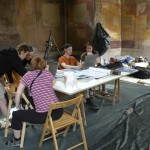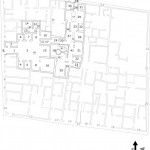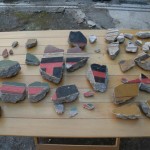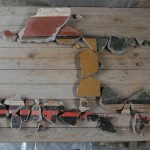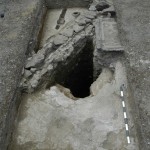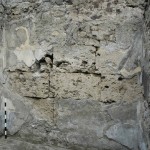The 2005 field season took place in May and the number of participants was largest so far. About half of the staff consisted of our own researchers and students and the other half came from EVTEK University of Applied Sciences.
Work concentrated in the eastern and northern parts of the House of Marcus Lucretius. Buildings archaeological work was conducted in ten rooms (16, 25-34) and by the end of the season, the documentation of the House of Marcus Lucretius was completed. The documentation of wall paintings continued in the rooms of the atrium complex. Work was started in house IX 3,25 where buildings archaeology was started in three rooms.
The excavation of the garden (room18) was continued by expanding the 2004 trenches and by finishing the buildings archaeological work in the area. Trench BD in the southern side proved out to be significant as the possible 6th century BC wall was discovered there. The wall consists of two courses of pappamonte tuff blocks (c. 1,5 m long and 0,5 m high) partly under later structures. It is very similar to other 6th century walls found in Pompeii and the abundant pottery finds from the same period found from the layers next to the wall strengthen the date. Trench BC in the north side of the garden was also expanded. Two large waste pits for building debris were found next to the fountain and the basin in the central part of the garden. Thousands of fragments of First and Second Style paintings were found. In addition, two smaller waste pits containing mostly pottery were found: one in the northern edge with mostly lamps and another one in the southern edge, partly cut byt the northern wall of the large dining room (room 16) south of the garden.
The wall painting fragments were studied by the EVTEK team: their pigments were analysed and a reconstruction of decorative scheme was made. Digital methods for making the fragment puzzle were experimented upon as well.
The northern part of the house (house IX 3,24) was originally probably an independent dwelling and its ground plan was that of a row house or an atrium house without side rooms. Its facade consists of massive travertine blocks which suggest an early date for that part of the house. Three trenches were dug inside house 24: trench CB in the transition area (rooms 26-27) between houses 5 and 24, trench CA in the atrium (room 29) and a small trench CC in the doorway to room 31 in the northwestern edge of the house. The aim was to try and find earlier floor levels as it was possible to see a blocked window at a fairly low level in the facade wall. Another important question was to try to find out when the two houses were joined.
Work in trench CB did not reveal any walls but instead many other features, including two drain channels taking moisture away from the garden area as well as a fairly small waste pit with mostly building debris. In the southern part of the trench a sequence of two floors could be found close to the last phase plaster floor. These same floors as well as another, earlier one were also found in trench CA. These covered what could be an abandoned cistern filled with soil. A tentative date for the beginning of the floor sequence is 1st century BC, but as there were no finds from the soil layers between the plaster floors, a more accurate date cannot be given. The floors were partly destroyed when a small waste pit was dug through them probably in connection with the last phase rebuilding. Some pieces of the same First Style wall painting were found in the fill of this waste pit, in the garden waste pits as well as in the fills of the old basins by the west wall in the atrium of house 24 (room 29).
Trench CC was dug in the doorway between rooms 29 and 31 and the aim was to try to get some data on the early walls in that area. Some fill layers and remains of a removed threshold could be found. A small deposit of coins was found by the eastern wall of room 31 and analyses of the coins suggests a fairly early date.
All the excavated trenches in houses 5 and 24 featured only 50-60 cm of human-made stratigraphy before finding untouched volcanic layers. Only the various pits run deeper than that. No fill layers could be observed. Most of the material culture is from the 1st century BC of later.

